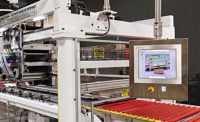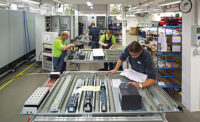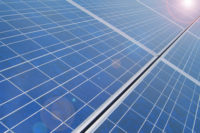Traditional solar panel installations require expensive and time-consuming assembly of custom mounting systems on a roof, which can ultimately slow adoption. For the last four years, SMASH Solar Inc. (SSI) has been providing installers an easier way to install solar panels—and increase their popularity among homeowners.
The Richmond, CA-based company preassembles frameless photovoltaic modules that snap in place on a roof with the company’s patented SMASHmount system. This system adheres to the back of panels and enables them to be quickly installed with no field modifications or complications. Troy Tyler, founder and CEO of SSI, says installers fondly refer to the system as “solar LEGOs.”
Assembly of prototype modules was done manually. This approach proved to be very slow and wasteful of material (30 to 40 percent). It also resulted in inconsistent output quality due to no process controls. Equally important, SSI management realized that manual assembly could neither be scalable nor deliver precision modules that ensure smooth and consistent field installation.
Aware of these limitations, company engineers worked with TM Robotics (TMR) to design an assembly line that would optimize module precision, repeatability and throughput. TMR sells and supports a wide range of SCARA, Cartesian and six-axis industrial robots made by Toshiba Machine Co. America.
Both parties determined that assembly of the SMASHmount system required a robot with an arm length greater than 1,200 millimeters and a payload capacity greater than 20 kilograms. TMR recommended Toshiba’s two-axis BA-III Cartesian robot for three reasons.
First, it does not require a moving conveyor, enabling SSI to fit multiple assembly stations within its current facility (a converted 100-year-old cannery). Second, the robot is affordable for a fairly young manufacturer. Third, the robot easily integrates with the standard automation protocols and electronics used on SSI’s production line.
The robot’s X axis is a BE50F Compo Arm (2,200-millimeter stroke), and the Y axis is a BE30E Compo Arm (1,000-millimeter stroke). This combination provides a 40-kilogram maximum payload across a large work area. The robot features 16 standard inputs and 16 outputs, but also supports an additional 24 inputs and eight outputs.
During assembly, the robot carries an adhesive dispenser to precise locations on the PV module where mounting parts are attached. Once the mounting system is affixed, the module continues down the assembly line to other workstations.
“Controlling the location and speed of adhesive application is critical,” explains Tyler. “Precision with rapid movement needs to be maintained over a large area, to ensure the glue is placed properly and within cure-time limits.”
Thus far, the robot has proven cost-effective. Tyler says it has doubled SSI’s throughput with half the manufacturing staff. He also notes the importance of TMR’s free two-day training program to ensure optimum robot performance. Offered to first-time Toshiba Machine customers, this program coincides with the delivery of the robot so users lose no production time.
BA-III robots are available with one to four axes and designed to handle light, medium and heavy loads. They feature oil-free seals in the linear motion guides and ballscrews, eliminating maintenance for an extended period of time. Also standard is an AC servomotor with short axial length.
For more information on Cartesian robots, call 847-709-7308 or visit http://tmrobotics.com.





